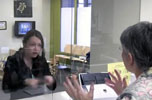
Summary
 In this online module, you have learned a variety of tips and strategies for improving commu
In this online module, you have learned a variety of tips and strategies for improving commu nication access for clients who are deaf or hard of hearing. This is a quick summary of take-away points.
nication access for clients who are deaf or hard of hearing. This is a quick summary of take-away points.
- Ask the client what works best for communication. Recognize the diversity of clients who have a hearing loss and that one size does not fit all. Asking the client will help you to provide the highest quality client-centered care.
- Identify different strategies for communicating effectively. Some clients may use assistive listening devices, such as hearing aids, cochlear implants or FM systems. Other clients may rely on written communication. Some clients may request interpreters which can be either sign language interpreters, tactile or oral interpreters.
- Know how to schedule interpreters if requested. Find out the policy of your facility. While each system may be different, checking with social services, the emergency department, or the main switch boards are good places to start.
- Address the client directly. Whether working with an interpreter or not, talk directly to the client and look at the client, not the interpreter or family member or companion.
- Ensure appropriate lighting for communication. Whether a client is hard of hearing and relies on lipreading, or Deaf and uses sign language, clients with hearing loss generally use vision as part of communication. Check with the client to see what lighting is appropriate.
- Know who to provide communication access for. In addition to clients, ensure that communication access is provided for companions or family members who are part of the care team and might be called on to take part in making medical decisions.
- Understand that effective communication helps you more efficiently do your job in providing the highest quality client-centered care. Whichever of the strategies used to provide access, the efforts you make to ensure communication will benefit you in doing your work and ultimately lead to a higher level of client care.
—
Congratulations! You have now finished the training.
Resources
Resource List
- Deaf and Hard of Hearing Services Division of the Minnesota Department of Human Services
provides a variety of resources for working with people who are Deaf, DeafBlind or Hard of Hearing. - InterpreterReferral.org (For information on interpreting and referral agencies.)
- ADA.gov – for information and technical assistance on the American with Disabilities Act
Further Use/Credits
Further Use/Credits
Copyright Notice
All material contained within the curriculum is owned by DHS unless otherwise stated or implied by the nature of the material, such as quotations attributable to other sources. All rights are reserved. Your use of the materials is limited to not-for-profit, non-commercial use. Because this material is intended for public use, a license to copy for limited use is granted where proper credit is given to DHS as the source and, where appropriate, to the author of the material. Permission is granted to print and distribute unmodified copies of the curriculum for non-commercial personal and third party use. For the avoidance of doubt, license granted above does not permit you to incorporate all or any part of the contents of this curriculum into any commercial publication or document, or for any other for-profit or commercial purpose without the written permission from DHS.
Using This Curriculum
This project is designed to improve the care and experiences of clients who are Deaf, DeafBlind and Hard of hearing. County public health and human service departments, and other organizations, wishing to use this in the in-service of their staff may do so as long as they abide by the terms of the Copyright notice above. If you have questions on its use, you may contact:
Cheryl A. Blue, Consultant
Deaf and Hard of Hearing Services~NE, Duluth
866-552-2692 Direct VP | 866-488-3836 TTY| cheryl.blue@state.mn.us
In Gratitude
Special thanks to Jack Bender for inspiring this project.
This was a collaborative effort and the Minnesota Department of Human Services wishes to acknowledge the may contributions bringing it to completion.
Deaf and Hard of hearing individuals who shared their experiences
- Barb Urick
Introductory Video
- Jennifer Langdon-Larson
- Mary Bridget Lawson
- Renee Van Nett
Working with Interpreter Video
- Doug Bowen-Bailey
- Kyle Elden
- Todd Pleski
Video Model for Lipreading Activity
- Xavier Bell
Project Team
- Doug Bowen-Bailey, Digiterp Communications
- Cheryl Blue, Minnesota Department of Human Services – Deaf and Hard of Hearing Services Division ~ Northeast
- Mary Bridget Lawson, St. Louis County Public Health & Human Services
- Juli Lattner, St. Louis County Public Health & Human Services
- Shelly Sauko, St. Louis County Public Health & Human Services
- Nancy Christensen, St. Louis County Public Health & Human Services
- Catherine Roseth, St. Louise County Human Resources

